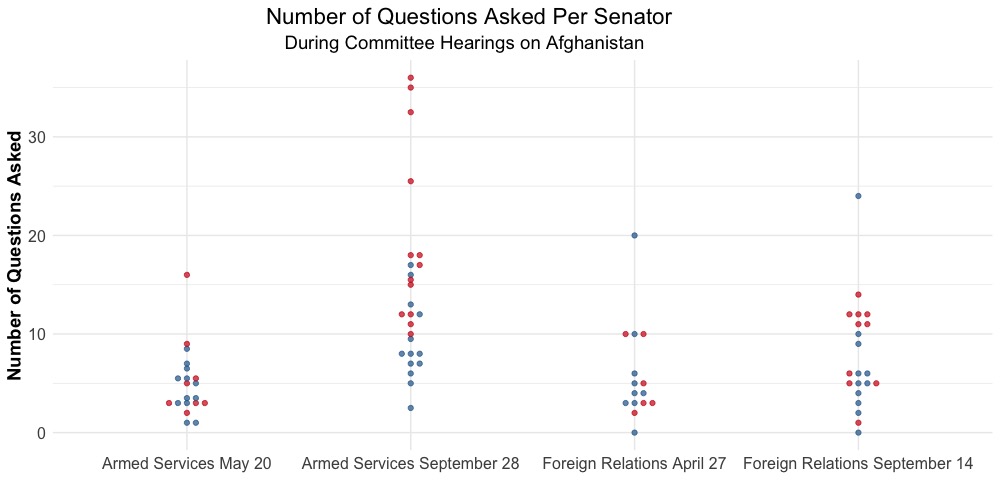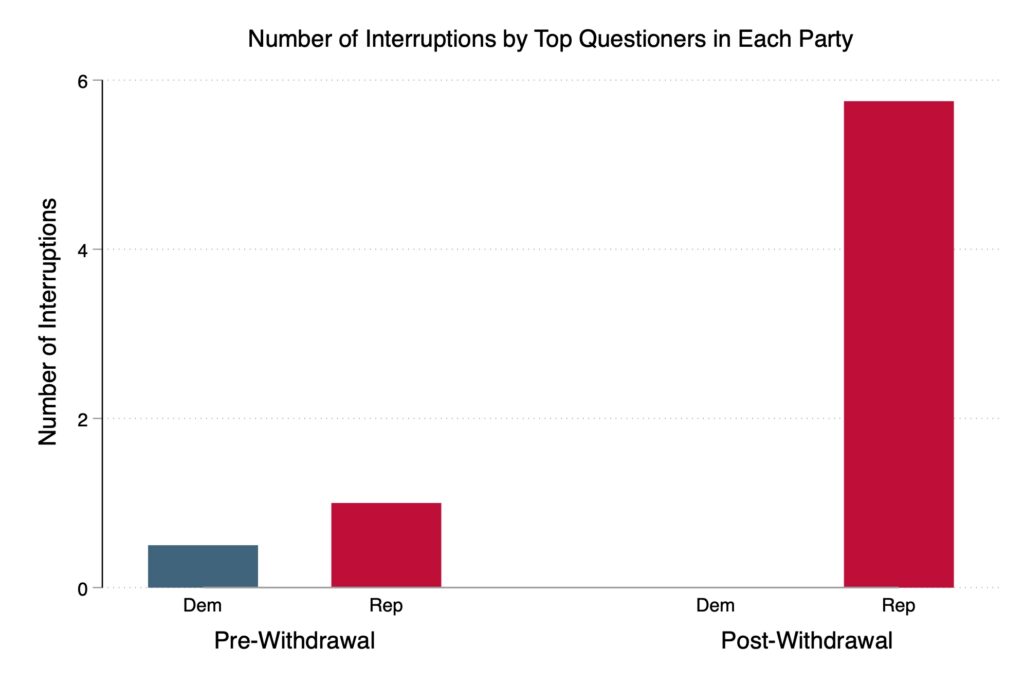By Ethan Brill-Cass ’23, Khari Derrick ’22, and Breeze Floyd ’22
Soon after the September 11 attacks in 2001, American troops arrived in Afghanistan for what would become a twenty-year engagement. Throughout that time, various related issues received congressional attention. In February 2020, the Trump administration established a comprehensive peace agreement with the Taliban. The United States agreed to reduce forces in Afghanistan, with a complete withdrawal of troops completed by May 1, 2021. However, it was not until August 2021, seven months after the Biden Administration took over the withdrawal process, that the situation received significant attention in the media and entered public discourse. In this post, we analyze hearing transcripts from the U.S. Senate Armed Services Committee and U.S. Senate Foreign Relations Committee hearings both before and after the heavily criticized August withdrawal.
The pre-withdrawal hearings took place in April and May and post-withdrawal hearings took place in September. Table 1 shows the number of senators participating in the hearings, with the number of senators participating increasing in both the Foreign Relations and Armed Services Committee post-withdrawal.

We also counted frequently used words by both parties. In the April Foreign Relations hearing, Republicans’ top words included ‘Taliban’ (18) and ‘forces’ (10). ‘Administration’ was used nine times and ‘Biden’ just once. Democrats’ most frequently used words included ‘Taliban’ (30) and ‘women’ (32). Twelve Democrats and eight Republicans participated in the May 20 Armed Services hearing. Some of the most common words used by Democrats were ‘Taliban’ (39), ‘support’ (32), ‘government’ (28), ‘security’ (26), and ‘troops’ (25). High-frequency words from Republicans included ‘Taliban’ (17), ‘forces’ (16), ‘security’ (12), and ‘withdrawal’ (10). Republicans said ‘administration’ three times and ‘Biden’ just once, compared to Democrats saying ‘Biden’ eight times. Although there are word choice differences between Republican and Democratic members during these two committee hearings, the contrasts are more notable during the September hearings.
Members used several words in September that were less commonly used in April, including ‘Biden,’ ‘president,’ and ‘American.’ Analyzing the September 28, 2021 U.S. Senate Armed Services Committee hearing transcripts reveals several word choice differences between parties. Most notably, Republicans said ‘president’ 129 times, compared to Democrats, who said it just 27 times. A similar distinction exists between mentions of ‘Biden,’ with Democrats saying it 12 times compared to Republican members, who said ‘Biden’ 42 times. In contrast, ‘Trump’ received 13 mentions from Democrats and 15 mentions from Republicans. Common words for both parties during this hearing were ‘military,’ ‘Taliban,’ ‘withdrawal,’ and ‘women.’ While examining word frequencies between the parties during these hearings highlights differences, exploring style choices is also necessary.
Another stylistic choice we analyzed was the volume of questions that individual senators on each committee asked of their witnesses. Here, we counted the total number of questions that senators asked in order to discern patterns 1) over time, 2) across parties and 3) across committees. A “question” was defined as any statement made by a senator in the course of a hearing that was followed immediately by a response from a witness.
Unsurprisingly, the average number of questions asked of witnesses increased during the hearings held post-withdrawal (in September) as compared to those held pre-withdrawal (in April and May), for both committees. The combined average number of questions asked per senator during pre-withdrawal hearings was 5.4, compared to an average of 11.5 questions asked post-withdrawal, potentially owing to the two rounds of questions asked in the September Armed Services hearing, as opposed to only one in May.
Though members of both parties contributed to driving this increase, Republicans contributed to a much higher degree.
In the Senate, Democrats increased their average question volume by 10% on the Foreign Relations Committee, and 107% on the Armed Services Committee, while Republicans saw larger increases of 62% on Foreign Relations, and 241% on Armed Services. Overall, of 727 questions asked across four Senate hearings, Democrats asked 301 (41%) of them, while Republicans asked 426 (59%).
There was bipartisan criticism for the Biden administration’s handling of the withdrawal, both in Congress and amongst the public. Additionally, as discussed above, senator participation in hearings increased post-withdrawal. Together, these two factors likely led to increased question volume as senators raised their scrutiny of the officials responsible for the policy. Figure 1 shows the distribution of questions across all senators participating, with red dots indicating questions from Republican senators and blue dots indicating questions from Democratic senators.
Beyond total questions asked, we analyzed the frequency with which Senators interrupted those they were questioning. To collect these data, the two Senators with the highest number of questions asked per party per hearing were used. The hearings were then coded to collect the number of interruptions for the designated senators. Any question a senator asks that immediately follows a “–” was counted as an interruption, as this denotes the Senator beginning to speak before the end of the previous individual’s sentence. Figure 2 shows the average number of interruptions by the top questioners in each party in the pre- and post-withdrawal hearings.
Interestingly, only a single Democrat of the eight who asked the most questions for a hearing interrupted anyone in doing so, whereas six Republicans made at least a single interruption. This may be the result of Republicans being on average more aggressive in questioning than Democrats or possibly because Republicans might have perceived they had more to gain from aggressive questioning on the topic of Afghanistan.
Additionally, both the total number of interruptions and the percentage of Republican questions that were interruptions increased from before to after the withdrawal. It is possible that after the withdrawal Republicans saw an even greater potential benefit to aggressive questioning because they could criticize or hurt President Biden in doing so.
The hearings held at the tail end of the twenty-year engagement in Afghanistan offer many opportunities for analysis, including language analysis. Exploring these hearings reveals differences between the parties. While many of the most common words appear for both parties, there are also some significant differences, especially post-withdrawal mentions of President Biden. While it is unsurprising that Republican members frequently referred to Biden post-withdrawal, the low frequency of Democratic mentions of Trump is interesting. Also unsurprising is that, in the course of this foreign policy crisis, managed by a Democratic administration, Republican scrutiny of witnesses seemed to be the highest (though question counts for both parties increased). In early 2020, when Trump established the initial peace agreement, the issue received less attention than it did in 2021. Extending this analysis to include earlier hearings, especially during Republican administrations, would likely reveal more significant changes.

